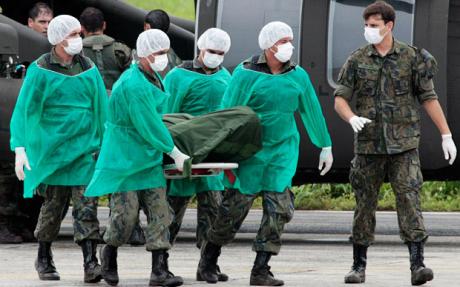
The identification of bodies from Air France flight 447 that disappeared out of the sky en route from Brazil to France may hold vital clues to the tragedy that claimed 228 lives.
Investigators believe that comparing where the passengers were sitting and where their bodies were found in the ocean could provide information about when the doomed aircraft broke up after vanishing over the Atlantic on May 31.
A desperate race against time and worsening weather is on to find the plane's black boxes, the best hope of establishing exactly what went wrong, but in their absence experts are having to piece together clues from the victims and debris found in the sea.
As the search continues the family of one of the victims has filed a civil action in order to force investigators to hand over information about the crash.
Maître Sophie Bottai, representing the parents, brother and girlfriend of an unnamed 38-year-old passenger from Paris, said they "had the feeling that a part of the truth was not being told".
She added: "Given the clear filtering of information, certain families of victims of the crash of flight AF447 feel that the whole truth has not been told on the subject.
"We want simple answers to simple questions; for example why was there such a delay between the last signal from the plane and the moment the authorities raised the alarm."
The lawyer said the family was desperate but ready to fight. "The further the inquiry advances the more we have the impression that this catastrophe could have been averted. In any case, that's the question being asked," she added, saying the families of other victims had also contacted her about the civil lawsuit.
A criminal inquiry against "unknown persons" for involuntary homicide, or manslaughter, has been opened into the crash in France and by becoming civil plaintiffs, the family will have access to the investigation files.
In response to the criticism, Pierre-Henri Gourgeon, the director general of Air France insisted: "Nothing is being hidden."
A total of 50 bodies have now been picked up by Brazilian military ships 400 miles north east of the Fernando de Noronha islands off Brazil's northern coast. Other debris including two plane seats, oxygen masks, water bottles and several pieces of the plane's fuselage have been found. But on Friday the search was hampered by worsening weather.
Some of the bodies have been discovered more than 50 miles apart, which could indicate the plane broke up at high altitude or reflect the strong currents in the region. Investigators hope determining where victims were sitting and establishing their injuries will yield more clues.
The corpses are being transported to Recife on the east coast of Brazil for autopsies.
Roman Cardoso, Brazil's air force general, said there was a "very remote" chance that all bodies would be found: "It is becoming more and more difficult to find and recovering bodies," he added.
Peter Goelz, former managing director of the US National Transportation Safety Board, said the evidence so far pointed to a partial mid-air break up of the Airbus A330.
He said the bodies found were among the best evidence investigators had. As flight 447 was going through heavy storms at the time it disappeared the passengers, including five Britons, were probably in their allocated seats.
"If the victims found in one part of the ocean mostly came from one part of the plane, and the victims in the other area from another part of the plane, that is really telling you something," Mr Goelz said.
Identification of injuries suffered by passengers will also help investigators. Mr Goelz noted that the pattern of injuries found on passengers of TWA Flight 800 - which went down in 1996 off New York's Long Island - helped investigators confirm that the nose of the plane broke off and fire blew back from the fuel tank.
Air France and Airbus have reacted angrily to increasing speculation about the possible cause of the accident.
Last Thursday Air France demanded that several international airports remove the newspapers Le Figaro from sale after the paper published an article criticising the company for allegedly not replacing speed sensors on the Airbus A330 quickly enough following advise to do so from the plane's manufacturer, Airbus.
The message read: Hello. LE FIGARO. We ask you not to load today FIGARO edition - on board AF flights - At boarding gates - In Lounges.
Thanks coop.
"Playing with hypotheses about safety or speculating on the causes of the accident is irresponsible," said an Airbus official.




Reader Comments
to our Newsletter